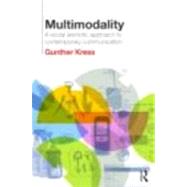
Note: Supplemental materials are not guaranteed with Rental or Used book purchases.
Purchase Benefits
What is included with this book?
| List of illustrations | p. xi |
| Preface | p. xiii |
| Acknowledgements | p. xvii |
| Where meaning is the issue | p. 1 |
| Multimodality: simple, really | p. 1 |
| From semiotic system to semiotic resource | p. 5 |
| Cultural difference and communication: the 'reach' of the theory and the 'reach' of modes | p. 8 |
| The politics of naming | p. 12 |
| A satellite view of language | p. 15 |
| The social environment of contemporary communication | p. 18 |
| An ethical approach to communication | p. 18 |
| Assumptions | p. 19 |
| Environments for communication: social frames and communicational possibilities | p. 19 |
| Power, authority and authorship | p. 21 |
| Social and theoretical consequences: ruling metaphors of participation, design, and production | p. 22 |
| Personal choices: existential insecurity or agency through participation and connection | p. 23 |
| Communication and meaning: fluidity, provisionality, Instability | p. 23 |
| A prospective theory of communication: rhetoric, design, production | p. 26 |
| From language and grammar to semiotic resources | p. 27 |
| Mobility and portability | p. 28 |
| A word on 'pace' | p. 29 |
| The need for apt metaphors | p. 30 |
| Communication: shaping the domain of meaning | p. 32 |
| Communication as semiotic work: a sketch of a theory | p. 32 |
| 'Reading' and the reader's design of meaning | p. 37 |
| Provisionality in communication: rhetoric and design, newly configured | p. 43 |
| Environments of communication: a historical view | p. 46 |
| Refashioning social and semiotic domains: rhetoric and design | p. 49 |
| A social-semiotic theory of multimodality | p. 54 |
| From a linguistic to a multimodal social-semiotic theory of meaning and communication | p. 54 |
| Linguistics, pragmatics and a social-semiotic approach to representation | p. 56 |
| Horses for courses: apt theories, useful framing | p. 60 |
| The motivated sign | p. 62 |
| The everyday, the banal and the motivated sign | p. 65 |
| Interest and the partiality of representation | p. 70 |
| Mimesis, signs and embodied experience | p. 76 |
| Mode | p. 79 |
| Materiality and affordance: the social making of mode | p. 79 |
| The 'reach' of modes | p. 83 |
| What is a mode? | p. 84 |
| Is layout a mode? | p. 88 |
| Mode, meaning, text: 'fixing' and 'framing' | p. 93 |
| Mode as technology of transcription | p. 96 |
| Meaning as resource: 'naming' in a multimodal social-semiotic theory | p. 103 |
| Naming aptly | p. 103 |
| New frames, new names | p. 105 |
| Making signs: resources, processes and agency | p. 107 |
| Processes and effects:-making and remaking meaning | p. 120 |
| Design and arrangements: making meaning material | p. 132 |
| Design in contemporary conditions of text-making | p. 132 |
| Design an essential (re)focusing | p. 133 |
| What is design? A homely example | p. 135 |
| Design in social-semiotic environments | p. 137 |
| Changes in design: a brief look at recent history | p. 141 |
| Arrangements: making meanings material | p. 145 |
| What else is framed? | p. 153 |
| Discourse: ontological and epistemological framing | p. 157 |
| Multimodal orchestrations and ensembles of meaning | p. 159 |
| The world arranged by me; the world arranged for me | p. 159 |
| The world arranged by me, the world arranged for me: orchestrating ensembles, staging of movement, motion, 'pace' | p. 162 |
| Aesthetics, style and ethics in multimodal ensembles | p. 169 |
| Applying the theory: learning and evaluation; identity and knowledge | p. 174 |
| Learning and identity in a communicational frame | p. 174 |
| Reading as design | p. 175 |
| Semiosis, meaning and learning | p. 178 |
| Recognition, metrics and principles of assessment | p. 182 |
| The social semiotics of convergent mobile devices: new forms of composition and the transformation of habitus | p. 184 |
| The social frame for the semiotic analysis | p. 184 |
| The affordances of Smartphones: a social-semiotic account | p. 185 |
| Affordances of the hardware | p. 186 |
| 'Shape': designers' intentions and social implications | p. 187 |
| The representational affordances | p. 187 |
| The functionalities | p. 189 |
| Mobile Web access and usability: changes in social habitus | p. 190 |
| Implications | p. 193 |
| Gains and losses: some open questions | p. 195 |
| References | p. 198 |
| Index | p. 205 |
| Table of Contents provided by Ingram. All Rights Reserved. |
The New copy of this book will include any supplemental materials advertised. Please check the title of the book to determine if it should include any access cards, study guides, lab manuals, CDs, etc.
The Used, Rental and eBook copies of this book are not guaranteed to include any supplemental materials. Typically, only the book itself is included. This is true even if the title states it includes any access cards, study guides, lab manuals, CDs, etc.